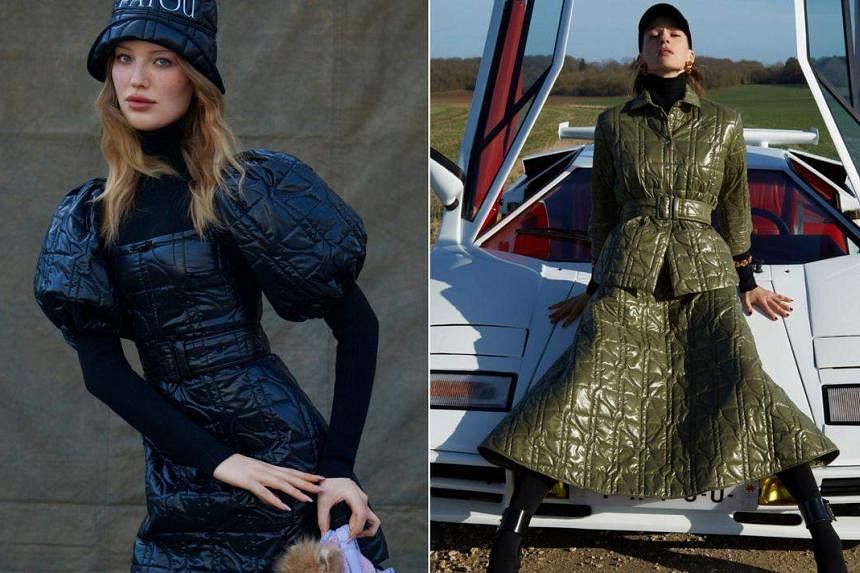This article first appeared in Harper’s Bazaar Singapore, the leading fashion glossy on the best of style, beauty, design, travel and the arts. Go to harpersbazaar.com.sg and follow @harpersbazaarsg on Instagram; harpersbazaarsingapore on Facebook. The September 2022 issue is out on newsstands now.
SINGAPORE – Sometimes, the stars align and the combination of a revered historic brand with a young designer who has his or her finger on the pulse and eye on the future can create explosive, compelling results.
The European fashion capitals are home to a few such thrilling designer-house pairings.
One of the visionary talents reviving heritage brands is Daniel Roseberry at Schiaparelli, who translates Elsa Schiaparelli’s 20th-century Surrealist fantasies through a 21st-century vocabulary of theatricality that is like catnip for the Instagram crowd – resulting in some of the most memorable red-carpet and stage looks for today’s most boldfaced names.
At Courreges, Nicolas di Felice is presenting a new dynamic take on the legacy established by Andre Courreges – one that remixes the founder’s 1960s, Space Age sensibilities with a cool, club-kid spin. The designer – who trained under Nicolas Ghesquiere at Balenciaga and Louis Vuitton, and Raf Simons at Dior – has retained the clean lines and striking geometric shapes that characterised the founder’s work, but injects inflections that reflect the realities of fashion today. Think A-line minis and sheaths, and boxy vinyl jackets, but accented with graphic cutouts and worn with athletic bandeaus, baseball caps, cropped tees and ribbed knit flared pants.

Even the vinyl – a signature of the house – has been remade in a more eco-friendly way. “I try to extract the essence without copying the past” is how the designer once described his approach in an interview.
For others, like Nicola Brognano at Blumarine, it is not so much about referencing the past, but evoking a certain mood. If that mood is steeped in nostalgia, so be it. So much of fashion now is informed by a nostalgia for decades past anyway.
Since his debut for the label during the fall/winter 2021 collection, the designer has presented a vision for Blumarine that is sweet and sexy in equal measure. With its unabashedly girly mix of butterflies and roses, and pink and glitter, it is a look that harks back to reality television star Paris Hilton, singer Britney Spears and actress Lindsay Lohan – those celebrity trendsetters of the 2000s who flocked to the Italian brand for its fun, flirty dresses.

Now, with the renaissance of everything Noughties in full swing, Brognano’s vision is proving resonant with a new set of style icons – the likes of singers Dua Lipa, Ariana Grande and Olivia Rodrigo have all turned to him for his midriff-baring tops; bell-bottomed, bedazzled jeans; and shrunken cardigans with faux-fur necklines worn over beaded bras and little flouncy skirts.
For fall/winter 2022, the designer pushes Blumarine into sultrier territory – more grown-up, a little more dressed up, but still undeniably femme and camp. Candy colours give way to a palette of dark hues and rich jewel tones; breasts are accented by knitted rosettes; ruched and ribboned crotch-skimming dresses are worn with sheer stockings, and unbuttoned silk shirts with plush giant faux-fur chubbies.
“From the heritage of the brand, I wanted to revisit the sense of sensuality – not in a vulgar way, but with irony and lightness of touch,” was how the designer put it in an interview for online women’s streetwear platform, Hypebae.
A sense of lightness is also evident in the way the House of Jean Patou has been revived by Guillaume Henry.

Patou was a contemporary of Coco Chanel who helped liberate women from the corset with designs that emphasised ease and movement. He was also one of the first designers to put his stamp on sportswear, creating clothes that were both chic and functional.
After his death in 1936, there was an illustrious roster of successors that included Karl Lagerfeld, Jean Paul Gaultier and Christian Lacroix, but the brand has laid dormant since the late 1980s until it was bought in 2018 by LVMH, who installed Henry at the helm.
Henry is best known for resuscitating Carven – another forgotten Parisian couture house – as a contemporary fashion brand.
For Patou, Henry keeps the couture spirit but reinterprets it through a decidedly modern, youthful lens. The result: clothes with a distinctive design personality that stand out on social media, but are easy to wear, effortless to reconfigure – Henry is fond of a dressy look composed of separates – and, perhaps most importantly, approachable in terms of price points relative to the rest of the luxury fashion industry.
A few seasons in, he has fine-tuned a formula that brings together Provencal breeziness and Parisian glamour, playfulness and polish, cuteness and chic.

As the designer explained in an interview for the Federation de la Haute Couture et de la Mode: “There has to be a connection or dialogue between the couture atelier and the street. The couture feeling is still there, but it’s less theatrical. I always love turning the extraordinary into the ordinary. To compare it to the food industry, I like it to be easy to digest, not overly complicated, but it has to be tasty.”
Safe to say, Henry and his contemporaries have all fashionistas’ appetites whet.


